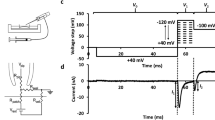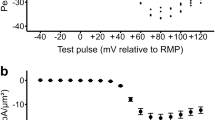Abstract
The mechanism underlying the hyperpolarization induced by isoprenaline in mouse lumbrical muscle fibres was studied using cell-attached patch and intracellular membrane potential (V m) recordings. Sarcolemmal inwardly rectifying K+ channels (KIR: 45 pS) and Ca2+-activated K+ channels (BK: 181 pS) were identified. Exposure to isoprenaline closed KIR channels and increased BK channel activity. This increase was observed as a shift from 50 to −40 mV in the voltage dependence of channel activation. Isoprenaline prevented hysteresis of V m when the extracellular [K+] fell below 3.8 mM. This hysteresis was due to the properties of the KIR. The effects of chloride transport and isoprenaline on V m did not interact purely competitively, but isoprenaline could prevent the depolarization induced by hyperosmotic media equally as well as bumetanide, which inhibits the Na+/K+/2Cl− cotransporter. In lumbrical muscle this leads to hyperpolarization, but this might vary among muscles. The switch from KIR to BK as the component of total K+ conductance was due to isoprenaline.







Similar content being viewed by others
References
Armstrong CM, Taylor SR (1980) Interaction of barium ions with potassium channels in squid giant axons. J Gen Physiol 30:473–488
Brinkmeier H, Zachar E, Rüdel R (1991) Voltage-dependent K+ channels in the sarcolemma of mouse skeletal muscle. Pflugers Arch 419:486–491
Cairns SP, Dulhunty AF (1995) The effects of β-adrenoceptor activation on contraction in isolated fast- and slow-twitch skeletal muscle fibres of the rat. Br J Pharmacol 110:1166–1141
Carmeliet E (1982) Induction, removal of inward-going rectification in sheep cardiac Purkinje fibres. J Physiol (Lond) 327:285–308
Choe H, Sackin H, Palmer LG (2001) Gating properties of inward-rectifier potassium channels: effects of permeant ions. J Membr Biol 184:81–89
Clausen T, Overgaard K (2000) The role of K+ channels in the force recovery elicited by Na+-K+ pump stimulation in Ba2+-paralysed rat skeletal muscle. J Physiol (Lond) 527:325–332
Cohen IS, DiFrancesco D, Mulrine NK, Pennefather P (1989) Internal and external K+ help gate the inward rectifier. Biophys J 55:197–202
Conley EC (1996) Intracellular calcium-activated K+ channels (KCa). In: Conley EC (ed) The ion channel facts book II. Intracellular ligand-gated channels. Academic Press, New York, Entry 27
Flatman PW, Creanor J (1999) Regulation of Na+-K+-2Cl− cotransport by protein phosphorylation in ferret erythrocytes. J Physiol (Lond) 517: 699–708
Gadsby DC, Cranefield PF (1977) Two levels of resting potential in cardiac Purkinje fibers. J Gen Physiol 70:725–746
Gallant EM (1983) Barium-treated mammalian skeletal muscle: similarities to hypokalaemic periodic paralysis. J Physiol (Lond) 335:577–590
Geukes Foppen RJ, Van Mil HGJ, Siegenbeek van Heukelom J (2001) Osmolality influences bistability of membrane potential under hypokalaemic conditions in mouse skeletal muscle: an experimental and theoretical study. Comp Biochem Physiol [A] 130:533–538
Geukes Foppen RJ, Van Mil HGJ, Siegenbeek van Heukelom J (2002) Effects of chloride transport on bistable behaviour of the membrane potential in mouse skeletal muscle. J Physiol (Lond) 542:181–191
Hamill OP, Marty A, Neher E, Sakmann B, Sigworth FJ (1981) Improved patch-clamp techniques for high-resolution current recording from cells and cell-free membrane patches. Pflugers Arch 391:85–100
Harvey RD, Hume JR (1989) Isoproterenol activates a chloride current, not the transient outward current, in rabbit ventricular myocytes. Am J Physiol 257:C1177–C1181
Hille B (1992) Ionic channels of excitable membranes, 2nd Edn. Sinauer, Sunderland
Ince C, Beekman RE, Verschragen G (1990) A micro-perfusion chamber for single-cell fluorescence measurements. J Immunol Methods 128:227–234
Kell MJ, DeFelice LJ (1988) Surface charge near the cardiac inward-rectifier channel measured from single-channel conductance. J Membr Biol 102:1–10
Koumi A, Wasserstrom JA, Ten Eick RE (1995) β-Adrenergic and cholinergic modulation of inward rectifier K+ channel function and phosphorylation in guinea-pig ventricle. J Physiol (Lond) 486:661–678
Kuba K, Nohmi M (1987) Role of ion conductance changes and of the sodium-pump in adrenaline-induced hyperpolarization of rat diaphragm muscle fibres. Br J Pharmacol 91:671–681
Kubo Y, Baldwin TJ, Jan YN, Jan LY (1993) Primary structure and functional expression of a mouse inward rectifier potassium channel. Nature 362:127–133
Kurachi Y (1985) Voltage-dependent activation of the inward-rectifier potassium channel in the ventricular cell membrane of guinea-pig heart. J Physiol (Lond) 366:365–385
Kurtz R, Schirm T, Jockusch H (1999) Maturation and myotonia influence the abundance of cation channels KDR, KIR and CIR differently: a patch-clamp study on mouse interosseus muscle fibres. Pflugers Arch 438:516–524
Lu T, Wu L, Xiao J, Yang J (2001) Permeant Ion-dependent changes in gating of Kir2.1 inward rectifier potassium channels. J Gen Physiol 118:509–521
Mallouk N, Jacquemond V, Allard B (2000) Elevated subsarcolemmal Ca2+ in mdx mouse skeletal muscle fibers detected with Ca2+-activated K+ channels. Proc Natl Acad Sci USA 97:4950–4955
Matsuda H, Stanfield PR (1989) Single inwardly rectifying potassium channels in cultured muscle cells from rat and mouse. J Physiol (Lond) 414:111–124
Mølgaard H, Stürup-Johansen M, Flatman JA (1980) A dichotomy of the membrane potential response of rat soleus muscle fibres to low extracellular potassium concentrations. Pflugers Arch 383:181–184
Palade PT, Barchi RL (1977) On the inhibition of muscle chloride conductance by aromatic carboxylic acids. J Gen Physiol 69:879–896
Rothberg B, Magleby KL (1999) Gating kinetics of single large-conductance Ca2+-activated K+ channels in high Ca2+ suggest a two-tiered allosteric gating mechanism. J Gen Physiol 114:93–124
Ruff RL (1999) Insulin acts in hypokalemic periodic paralysis by reducing inward rectifier K+ current. Neurology 53:1556–1563
Sakmann B, Trube G (1984) Voltage-dependent inactivation of inward-rectifying single-channel currents in the guinea-pig heart cell membrane. J Physiol (Lond) 347:659–683
Sejersted OM, Sjøgaard G (2000) Dynamics and consequences of potassium shifts in skeletal muscle and heart during exercise. Physiol Rev 80:1411–1481
Siegenbeek van Heukelom J (1991) Role of the anomalous rectifier in determining membrane potentials of mouse muscle fibres at low extracellular K+. J Physiol (Lond) 434:549–560
Siegenbeek van Heukelom J (1994) The role of the potassium inward rectifier in defining cell membrane potentials in low potassium media, analyzed by computer simulation. Biophys Chem 50:345–360
Standen NB, Stanfield PR (1978) Inward rectification in skeletal muscle: a blocking particle. Pflugers Arch 378:173–176
Tricarico D, Petruzzi R, Conte Camerino D (1997) Changes of the biophysical properties of calcium-activated potassium channels of rat skeletal muscle fibres during aging. Pflugers Arch 434:822–829
Van Mil HGJ, Kerkhof CJM, Siegenbeek van Heukelom J (1995) Modulation of the isoprenaline-induced membrane hyperpolarization of mouse skeletal muscle cells. Br J Pharmacol 116:2881–2888
Van Mil HGJ, Geukes Foppen RJ, Siegenbeek van Heukelom J (1997) The Influence of bumetanide on the membrane potential of mouse skeletal muscle cells in isotonic and hypertonic media. Br J Pharmacol 120:39–44
Vergara C, Latorre R (1983) Kinetics of Ca2+-activated K+ channels from rabbit muscle incorporated into planar bilayers. J Gen Physiol 82:543–568
Voets T, Droogmans G, Nilius B (1996) Membrane currents and the resting membrane potential in cultured bovine pulmonary artery endothelial cells. J Physiol (Lond) 49:95–107
Zemkova H, Svoboda P, Teisinger J, Vyskočyl F (1985) On the mechanism of catecholamine-induced hyperpolarization of skeletal muscle cells. Naunyn Schmiedeberg's Arch Pharmacol 329:18–23
Acknowledgements
We are grateful to the department of Physiology and Biophysics of the State University of New York at Buffalo, and to Lorin Milescu in particular, for the introduction to QuB. We are also grateful to Dr Gerard Borst for his advice and the use of the Sutter P-97 electrode puller, to Dr Wytse Wadman for his constructive remarks and to Dr Dirk Ypey for encouragement.
Author information
Authors and Affiliations
Corresponding author
Rights and permissions
About this article
Cite this article
Geukes Foppen, R.J., Siegenbeek van Heukelom, J. Isoprenaline-stimulated differential adrenergic response of K+ channels in skeletal muscle under hypokalaemic conditions. Pflugers Arch - Eur J Physiol 446, 239–247 (2003). https://doi.org/10.1007/s00424-003-1042-y
Received:
Revised:
Accepted:
Published:
Issue Date:
DOI: https://doi.org/10.1007/s00424-003-1042-y




